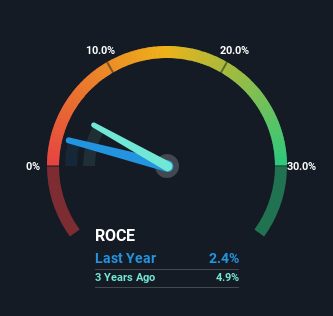Tsubaki Nakashima (TSE:6464) Might Be Having Difficulty Using Its Capital Effectively

If we want to find a stock that could multiply over the long term, what are the underlying trends we should look for? Amongst other things, we'll want to see two things; firstly, a growing return on capital employed (ROCE) and secondly, an expansion in the company's amount of capital employed. If you see this, it typically means it's a company with a great business model and plenty of profitable reinvestment opportunities. However, after briefly looking over the numbers, we don't think Tsubaki Nakashima (TSE:6464) has the makings of a multi-bagger going forward, but let's have a look at why that may be.
Return On Capital Employed (ROCE): What Is It?
For those who don't know, ROCE is a measure of a company's yearly pre-tax profit (its return), relative to the capital employed in the business. To calculate this metric for Tsubaki Nakashima, this is the formula:
Return on Capital Employed = Earnings Before Interest and Tax (EBIT) ÷ (Total Assets - Current Liabilities)
0.024 = JP¥3.7b ÷ (JP¥181b - JP¥28b) (Based on the trailing twelve months to June 2024).
Thus, Tsubaki Nakashima has an ROCE of 2.4%. Ultimately, that's a low return and it under-performs the Machinery industry average of 8.1%.
See our latest analysis for Tsubaki Nakashima

In the above chart we have measured Tsubaki Nakashima's prior ROCE against its prior performance, but the future is arguably more important. If you'd like, you can check out the forecasts from the analysts covering Tsubaki Nakashima for free.
So How Is Tsubaki Nakashima's ROCE Trending?
The trend of ROCE doesn't look fantastic because it's fallen from 7.5% five years ago, while the business's capital employed increased by 29%. That being said, Tsubaki Nakashima raised some capital prior to their latest results being released, so that could partly explain the increase in capital employed. It's unlikely that all of the funds raised have been put to work yet, so as a consequence Tsubaki Nakashima might not have received a full period of earnings contribution from it.
The Key Takeaway
Bringing it all together, while we're somewhat encouraged by Tsubaki Nakashima's reinvestment in its own business, we're aware that returns are shrinking. And investors appear hesitant that the trends will pick up because the stock has fallen 64% in the last five years. All in all, the inherent trends aren't typical of multi-baggers, so if that's what you're after, we think you might have more luck elsewhere.
If you want to continue researching Tsubaki Nakashima, you might be interested to know about the 2 warning signs that our analysis has discovered.
For those who like to invest in solid companies, check out this free list of companies with solid balance sheets and high returns on equity.
Valuation is complex, but we're here to simplify it.
Discover if Tsubaki Nakashima might be undervalued or overvalued with our detailed analysis, featuring fair value estimates, potential risks, dividends, insider trades, and its financial condition.
Access Free AnalysisHave feedback on this article? Concerned about the content? Get in touch with us directly. Alternatively, email editorial-team (at) simplywallst.com.
This article by Simply Wall St is general in nature. We provide commentary based on historical data and analyst forecasts only using an unbiased methodology and our articles are not intended to be financial advice. It does not constitute a recommendation to buy or sell any stock, and does not take account of your objectives, or your financial situation. We aim to bring you long-term focused analysis driven by fundamental data. Note that our analysis may not factor in the latest price-sensitive company announcements or qualitative material. Simply Wall St has no position in any stocks mentioned.
About TSE:6464
Tsubaki Nakashima
Manufactures and sells industrial precision balls, rollers, blowers, and medical equipment and hygiene equipment in Japan and internationally.
Good value second-rate dividend payer.
Similar Companies
Market Insights
Community Narratives




